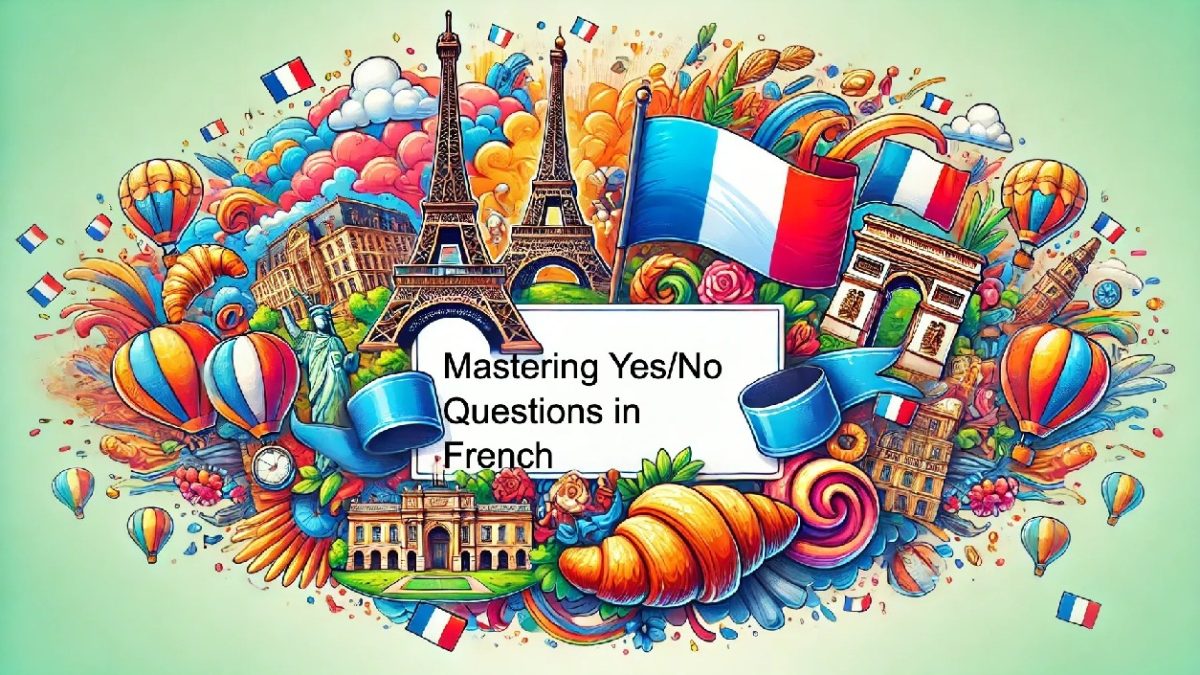
Using “Il y a” in French: A Comprehensive Guide for Beginners
August 6, 2024
Telling Time in French (L’Heure)
August 11, 2024Mastering Yes/No Questions in French: A Comprehensive Guide for Beginners
Learning how to ask and answer yes/no questions in French Grammar is one of the most fundamental skills for beginners. At the A1 level, mastering this basic aspect of French grammar will allow you to engage in simple conversations, gather information, and express your thoughts clearly. This comprehensive guide will cover the different methods of forming yes/no questions in French, provide plenty of examples, and offer tips on avoiding common mistakes. By the end of this article, you’ll have a thorough understanding of how to construct and respond to yes/no questions in French.
What Are Yes/No Questions?
Yes/no questions, as the name suggests, are questions that can be answered with either “yes” (oui) or “no” (non). In French, there are several ways to form these questions, each with its own nuances and appropriate contexts. The three primary methods for forming yes/no questions in French are:
- Intonation: Simply raising your voice at the end of a statement.
- Inversion: Inverting the subject and verb.
- Using “Est-ce que”: Adding “Est-ce que” at the beginning of a statement.
We’ll explore each of these methods in detail, providing examples and practice exercises.
Method 1: Yes/No Questions Using Intonation
The simplest way to form a yes/no question in French is by raising the intonation at the end of a declarative sentence. This method is common in informal spoken French.
Example:
- Statement: Tu parles français. (You speak French.)
- Question with Intonation: Tu parles français ? (Do you speak French?)
In this method, the word order of the sentence remains the same; the only difference is the rising intonation at the end, which indicates that it is a question.
More Examples:
- Statement: Il aime le chocolat. (He likes chocolate.)
- Question: Il aime le chocolat ? (Does he like chocolate?)
- Statement: Vous avez un chien. (You have a dog.)
- Question: Vous avez un chien ? (Do you have a dog?)
- Statement: Elle habite à Paris. (She lives in Paris.)
- Question: Elle habite à Paris ? (Does she live in Paris?)
Practice Exercise:
Convert the following statements into yes/no questions using intonation:
- Tu travailles demain. (You work tomorrow.)
- Ils viennent ce soir. (They are coming tonight.)
- Nous allons au cinéma. (We are going to the cinema.)
Answers:
- Tu travailles demain ?
- Ils viennent ce soir ?
- Nous allons au cinéma ?
Method 2: Yes/No Questions Using Inversion
Inversion is a more formal way to form yes/no questions in French. It involves inverting the subject and the verb. This method is often used in written French and in formal spoken contexts.
Example:
- Statement: Tu parles français. (You speak French.)
- Question with Inversion: Parles-tu français ? (Do you speak French?)
When using inversion, a hyphen is placed between the verb and the subject pronoun. If the verb ends in a vowel and the subject pronoun begins with a vowel (e.g., “il” or “elle”), a “t” is added between the verb and subject for euphony.
More Examples:
- Statement: Il aime le chocolat. (He likes chocolate.)
- Question: Aime-t-il le chocolat ? (Does he like chocolate?)
- Statement: Vous avez un chien. (You have a dog.)
- Question: Avez-vous un chien ? (Do you have a dog?)
- Statement: Elle habite à Paris. (She lives in Paris.)
- Question: Habite-t-elle à Paris ? (Does she live in Paris?)
Practice Exercise:
Convert the following statements into yes/no questions using inversion:
- Tu travailles demain. (You work tomorrow.)
- Ils viennent ce soir. (They are coming tonight.)
- Nous allons au cinéma. (We are going to the cinema.)
Answers:
- Travailles-tu demain ?
- Viennent-ils ce soir ?
- Allons-nous au cinéma ?
Method 3: Yes/No Questions Using “Est-ce que”
“Est-ce que” is a very common way to form yes/no questions in French, especially in spoken language. This method is neither formal nor informal and can be used in a variety of contexts. “Est-ce que” is placed at the beginning of a declarative sentence to turn it into a question.
Example:
- Statement: Tu parles français. (You speak French.)
- Question with “Est-ce que”: Est-ce que tu parles français ? (Do you speak French?)
Using “Est-ce que” is straightforward and avoids the need for inversion, making it easier for beginners.
More Examples:
- Statement: Il aime le chocolat. (He likes chocolate.)
- Question: Est-ce qu’il aime le chocolat ? (Does he like chocolate?)
- Statement: Vous avez un chien. (You have a dog.)
- Question: Est-ce que vous avez un chien ? (Do you have a dog?)
- Statement: Elle habite à Paris. (She lives in Paris.)
- Question: Est-ce qu’elle habite à Paris ? (Does she live in Paris?)
Practice Exercise:
Convert the following statements into yes/no questions using “Est-ce que”:
- Tu travailles demain. (You work tomorrow.)
- Ils viennent ce soir. (They are coming tonight.)
- Nous allons au cinéma. (We are going to the cinema.)
Answers:
- Est-ce que tu travailles demain ?
- Est-ce qu’ils viennent ce soir ?
- Est-ce que nous allons au cinéma ?
Responding to Yes/No Questions
Once you’ve mastered how to ask yes/no questions, it’s essential to know how to respond to them. The most straightforward responses are “oui” (yes) and “non” (no), but there are other ways to reply, depending on the context.
Examples:
- Question: Parles-tu français ? (Do you speak French?)
- Positive Response: Oui, je parle français. (Yes, I speak French.)
- Negative Response: Non, je ne parle pas français. (No, I do not speak French.)
- Question: Est-ce que tu aimes les chiens ? (Do you like dogs?)
- Positive Response: Oui, j’aime les chiens. (Yes, I like dogs.)
- Negative Response: Non, je n’aime pas les chiens. (No, I don’t like dogs.)
- Question: Il vient ce soir, n’est-ce pas ? (He’s coming tonight, isn’t he?)
- Positive Response: Oui, il vient ce soir. (Yes, he’s coming tonight.)
- Negative Response: Non, il ne vient pas ce soir. (No, he’s not coming tonight.)
Negative Responses
In French, to form a negative response, you generally wrap “ne” (or “n'” before a vowel) around the verb and follow it with “pas.” This structure is essential to convey a negative answer.
Example:
- Question: Est-ce que tu veux du café ? (Do you want some coffee?)
- Negative Response: Non, je ne veux pas de café. (No, I don’t want any coffee.)
More Examples:
- Question: Est-ce que vous habitez ici ? (Do you live here?)
- Negative Response: Non, je n’habite pas ici. (No, I don’t live here.)
- Question: Aime-t-elle le chocolat ? (Does she like chocolate?)
- Negative Response: Non, elle n’aime pas le chocolat. (No, she doesn’t like chocolate.)
- Question: Parlez-vous anglais ? (Do you speak English?)
- Negative Response: Non, je ne parle pas anglais. (No, I don’t speak English.)
Common Mistakes and Tips
- Avoiding Double Negatives: Unlike in English, where double negatives can emphasize negation, in French, double negatives should be avoided.
- Incorrect: Je ne parle pas rien.
- Correct: Je ne parle rien.
- Incorrect Inversion: When using inversion, ensure that the subject and verb are correctly inverted and that any necessary “t” is added.
- Incorrect: Aime elle le chocolat ?
- Correct: Aime-t-elle le chocolat ?
- Choosing the Right Method: Use “Est-ce que” for a neutral tone, intonation for informal situations, and inversion for formal contexts.
- Intonation: Tu veux du café ? (Informal)
- Inversion: Veux-tu du café ? (Formal)
- “Est-ce que”: Est-ce que tu veux du café ? (Neutral)
- Responding with Precision: While “oui” and “non” are often sufficient, adding the verb or subject back into your response can make your answer clearer.
- Example:
- Question: Est-ce que tu as fini ? (Have you finished?)
- Response: Oui, j’ai fini. (Yes, I have finished.)
Practice Exercises
Here are some exercises to help you practice forming and answering yes/no questions in French:
- Form Questions: Convert the following statements into yes/no questions using the method specified:
- (Intonation) Il pleut. (It is raining.)
- (Inversion) Tu aimes la musique. (You like music.)
- (“Est-ce que”) Vous venez demain. (You are coming tomorrow.)
Answers:
- Il pleut ?
- Aimes-tu la musique ?
- Est-ce que vous venez demain ?
- Answer the Questions: Respond to the following questions in both positive and negative forms:
- Est-ce que tu parles anglais ? (Do you speak English?)
- Est-ce que tu veux du thé ? (Do you want some tea?)
- Avez-vous un animal de compagnie ? (Do you have a pet?)
Answers:
- Oui, je parle anglais. / Non, je ne parle pas anglais.
- Oui, je veux du thé. / Non, je ne veux pas de thé.
- Oui, j’ai un animal de compagnie. / Non, je n’ai pas d’animal de compagnie.
- Correct the Mistakes: Identify and correct the mistakes in the following questions:
- Est-ce que il a un chien ?
- As tu fini ton travail ?
- Tu aime le chocolat ?
Answers:
- Est-ce qu’il a un chien ?
- As-tu fini ton travail ?
- Tu aimes le chocolat ?
Conclusion
Mastering yes/no questions in French Grammar is a crucial skill for effective communication at the A1 level. Whether you’re using intonation for informal conversations, inversion for more formal situations, or the versatile “Est-ce que” for neutral contexts, understanding how to construct and respond to these questions will significantly enhance your fluency and confidence in speaking French.
By practicing regularly, paying attention to common mistakes, and familiarizing yourself with the different methods of forming questions, you’ll be well-equipped to engage in basic conversations, ask for information, and express your thoughts clearly. Remember, the key to mastering yes/no questions is consistent practice and application in real-life scenarios. Bonne chance (good luck) on your journey to mastering French!

